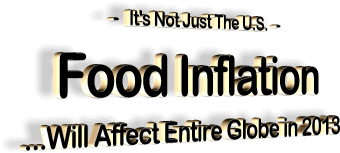
by J.D. Heyes
August 28, 2012
from
NaturalNews Website
Grocery prices in the United States have risen
steadily for months now, but because of the drought here at home and other
global market forces, food costs are set to skyrocket around the world as
well, say experts.
In addition to parched farmland throughout much of the U.S. and near the
Black Sea, weak monsoons in India and ongoing hunger across wide swaths of
Africa will all combine to drive food prices higher next year.
"We have had quite a few climate events this
year that will lead to very poor harvests, notably in the United States
with corn or in Russia with soya," Philippe Pinta of the French Farmer's
Federation warned recently.
If conditions persist beyond this year, analysts
note, it could be a repeat of 2007-2008, when food prices soared more than
six percent to a 25-year high, according to industry analysts and reports at
the time.
A year later, the UN said, prices had peaked to 30-year highs and in
December 2010 the food price index rose above its 2008 peak before dropping
to an 11-month low in October 2011.
Memphis, Tennessee-based
Informa said a study based on 20 years'
worth of food price data blamed soaring non-farm costs such as,
"record oil prices and soaring consumer
demand from the world economy, notably the emerging middle class in
Asia," were largely at fault, Reuters reported.
We've seen this before
Today, a similar combination of things, combined with a weather element, is
once more affecting world food prices.
While oil has retreated in recent days, prices remain high despite lower
demand, especially from the U.S., the world's largest oil consumer. That has
translated into higher costs for fuel that farmers must pay to harvest and
transport their crops.
A drought continues to grip much of the Midwestern United States, where corn
production has fallen to its lowest level in six years, according to the
Department of Agriculture, where diminished corn and soybean production will
likely contribute to higher costs.
In India, meanwhile, monsoon rains fell more than 15 percent below normal by
mid-August, meaning Asian rice prices are likely to increase by as much as
10 percent in the coming months.
Drought conditions have also hit parts of Africa's Sahel region, causing
food shortages. In fact, the relief agency World Vision Australia said 18
million people need food assistance in Niger, Mali, Chad, Mauritania and
Senegal.
If conditions don't change, it,
"could affect the crop prospects and may
have an impact on prices of essential commodities," Kuruppasserry Varkey
Thomas, India's agriculture minister, told the Bangkok Times.
Already, the prices for some items are being
affected by inflation.
"Cereal prices have shot up, with an
increase in (corn) prices of almost 40 percent since June 1,"
strategists at the CM-CIC brokerage noted.
In the U.S., the price of hamburger and other
meats, along with some dairy and corn-based products, have shot up.
Some cause for
optimism; some wiggle room
Not everyone is being pessimistic about food price increases.
Analysts with
the
United Nations Food and Agriculture Organization (FAO) say
they are expecting rice outputs to surpass the "excellent results" seen in
last year's crops, even though the agency cut its estimates for production
of un-milled rice to about 725 million tons from 732 million.
Still, it's clear harvests this year around the world are going to be
negatively impacted, and that has led some to call for measures aimed at
boosting food supplies in any way possible.
One such way would be for the U.S. to suspend its corn-ethanol mandate, says
FAO director general Jose Graziano da Silva of Brazil.
"An immediate, temporary suspension" of the
mandate requiring a substantial portion of corn crops to be used in
biofuels "would give some respite to the market and allow more of the
(corn) crop to be channeled towards food and feed uses," he wrote in the
Financial Times.
The jury is still out on that suggestion. A
Purdue University study published earlier this month found that suspending
the mandate could have some positive effects on prices by boosting
availability.
The suggestion seems like a no-brainer, but
remember, we are talking about
Washington, D.C.
Sources
